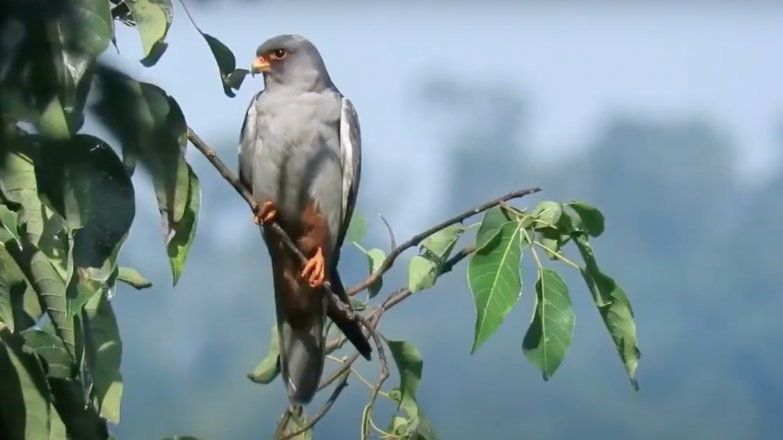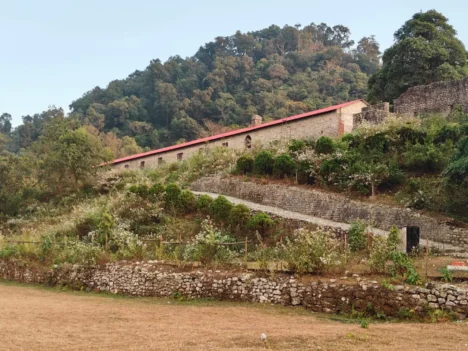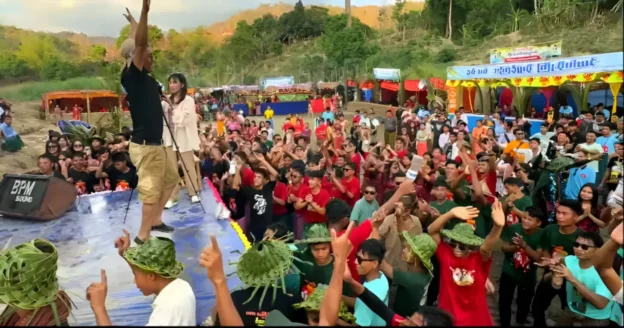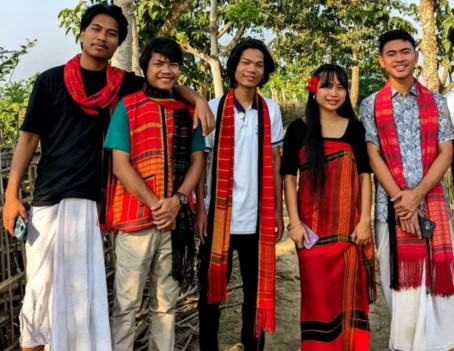The Borderlens online team in conversation with Bano Haralu
One of the smallest and prettiest birds of prey, the Amur Falcons were killed in thousands along the Doyang Reservoir in Nagaland’s Wokha district every year during their stopover midway through their flight covering 22,000 km from Mongolia to South Africa. The hunting of these birds rose to alarming levels to an estimated 120,000–140,000 every year, which is when the likes of Bano Haralu, a journalist and a conservationist, and other individuals and environmentalists set out on a mission to change people’s attitudes towards these birds, connecting people across continents. The Borderlens team caught up with Bano Haralu in her Dimapur home to understand how this process of change started in 2013, literally turning hunters into protectors.

The Amur Falcon travels across boundaries, isn’t that something so close to what we are? – Like we say it in The Borderlens – Beyond the lines
Yes, because the survival of the Amur Falcon (Falco Amurensis) depends on looking beyond yourself and your boundaries and maintaining these connections. The tiny raptors are unique in that they are perhaps the only species that connects all landscapes, from mountains, valleys, plains, and oceans. They undertake a trans-equatorial migration (crossing the Equator) from southeast Siberia to South Africa and back, amounting to a total of 22,000 km annually. During this flight, they cross 4000 km (twice) crossing over the Arabian Sea. This part of the sea is largely devoid of thermals, allowing the birds to soar, and here they must flap their wings continuously to keep afloat. It takes the raptor almost 60 hours to complete this crossing. Their God-given instinct to survive is linked with migration, and that sounds familiar in the context of the human race, does it not?
We all know of your inspiring story to save the Amur Falcons and we shall come to that in a bit. Before that, please tell us what is the one key learning lesson for you from this initiative. Or shall we say a life lesson that these migratory birds teach us?
The migration of the Amur Falcon reminds me of the phrase “nothing ventured, nothing gained”. The bird is a trans-equatorial creature (crossing the Equator) and its migration, the longest of any raptor in the world, is fraught with risks, but they are key to the survival of this species. Without embarking on this, they will be doomed in the snow and cold of the Siberian landscape. Their flight in turn is timed with the availability of their main food ‘termites’ and grasshoppers. Hundreds and thousands of termites emerge from the ground, coinciding with the migrating raptors! In Goa, in the Socorro Plateau, the Amurs reportedly feed on caterpillars on the grass. The migration of the raptors is another spectacular reminder of the secrets of this world we inhabit.
The lesson for me in the phenomenon of migration was observing the principle that when we do what we are meant to, despite the challenges, we maintain the cycle of life.
In contrast, the majority of the human race has the ability to reason and the freedom of choice to nurture and conserve nature. We exercise choice but not over the consequences.
What drove you to tell the world about the lives of these birds during their stopover here at the Pangti village in the Wokha district of Nagaland?
It’s quite by chance that I first heard about the raptors passing through Nagaland.
The two factors that led to the telling story of the migratory raptors passing through Nagaland were:
a) the contrast between a unique spectacle within Nagaland and the wanton massacre of the birds on the other hand.
b) the overnight turnaround of the community of hunters to the conservation of the raptors making the killing fields a safe haven for the migrating birds the very next season.
What were the challenges? Would you say conflicting positions were the toughest challenge when it came to convincing the people for whom hunting is a way of life to stop killing the birds and join hands to conserve them instead?
Yes, definitely talking about stopping the killing of the birds, which had become a seasonal lucrative earning for some families and for others a recreational sport, was not simple. But this effort measured against convincing the people to look at conservation as a way of life was and still is the toughest conversion in the field.
To me, hunting is a symptom of a deeply ingrained, conditioned subconscious response to a way of life that requires killing to survive. Awakening this sub-conscious to a fast changing world and viewing nature and its resources as “part” of one’s self rather than “separate” from one’s self is a decision that should not be put off. The sooner we make this decision, the better for the planet’s life.
Has your intervention started making people question themselves to think about what is right when it comes to wildlife and the environment?
I would certainly hope so, at least amongst the group of people I have had the opportunity to work and interact with over the years. The Amur Falcon migratory phenomenon gave a magnificent platform for the people of the state to engage in the theme of conservation and examine the influence our choices have on the conservation and continuation of all species lives. Hopefully, in the coming years, this conversation will become more vocal, leading us to make better decisions to live “naturally” better.
Surely, the situation of wildlife conservation is much different now than before. You also say in our interviews (based on a survey) that traditional knowledge about tribals protecting their forests and wildlife is a myth. Please explain.
Yes, this was a stark reality at the end of a random dipstick survey in May–June 2011 across eight different locations across Nagaland. The Action Document for the Forest Department by M.Sc. Wildlife Biology and Conservation interns, in collaboration with the Wildlife Conservation Society-India Programme and National Centre for Biological Sciences Bangalore for the Department of Forests, Ecology, Environment, and Wildlife Nagaland, showed rampant hunting and deforestation.
Hunting wildlife during the mating season or fishing during the breeding season is considered taboo. But the survey in 2011 showed a different picture. All year, hunting and deforestation emerged as the greatest threats to the health of the environment. The survey also showed that, contrary to the traditional wisdom of protecting watershed areas and water sources, there are more and more direct conflicts over water sources. The causes of conflicts erupt from water flow, diversion, salinization, floods, and pollution.
There is a greater need to create awareness about conservation and its long-term benefits.
Would you say there is pressure or tension in the way the local community connects with its environment? If so, then how should we address this concern?
There is certainly both tension and pressure in the manner in which local communities are made to connect with their environment. Poor management of resources, leading to poor yield from the fields, has invariably put pressure on the largely traditional agrarian community to view farming as a non-profitable occupation. This instead makes them explore deforestation or monocropping by planting cash crops as a more viable economic activity.
For decades, natural resources such as timber, cane, and medicinal herbs (to name a few) from the region have been taken out of the region without any value addition. Timber has been a major export, and wood-based industries are a rare sight. In contrast, thousands of sawmills operate to size the timber, which is then exported.
The use of technology, research-proven practices, and irrigation are virtually absent in the farming sector. The need is for a balance between traditional knowledge, the sciences, and modern technology to strengthen the connection of communities with their environment.
To this end, environmental and conservation awareness of the stakeholders about the unique biodiversity of the region and the inter-dependency of this wealth is an urgent response that is required.
Value addition to products from the region requires them to be promoted more aggressively, and this can be extended to the nascent and yet unexplored potential of the rich tradition of handicrafts from the region.
Finally, a stronger political will by state governments to address the issues of: Water, Clean Air, Waste & Land Pollution, and Climate Change.
Ecotourism and involving youths are great ideas. How do you think that could start? Now back to the birds and what we learn from them. We often hear that when birds migrate, farmers across continents await their arrival. How would you explain this phenomenon?
There is undoubtedly tremendous interest in the northeastern region of India amongst travellers. Ecotourism discourages the construction of heavy infrastructure and expensive investments and therefore is a preferred option for the growth of the travel industry. But there are also downsides to this concept if embarked upon without proper guidelines and sensitization of the community to the concept. It is equally important for the village councils to be educated about the impact of Eco-Tourism.
To my mind, exposure and training of interested entrepreneurs to successful models of Eco-Tourism in the country and its management is a good start.
Good hospitality is not in short supply, but to begin a business, it is important for the person to know some basic dos and don’ts by undergoing a training course. An important component of this training is the person’s knowledge of the history, customs, and traditions of his/her community.
Still, for Eco-Tourism to succeed, a proactive government is required to provide quality infrastructure with regard to good surface connectivity, water supply, and even electricity in the state.
The migration of the Amur falcons is woven into the natural cycle of farming, and so it appears as if the farming community is awaiting their arrival.
In northeast India, they arrive at the end of the harvest season (mid-October) and depart when the farmer begins to clear the fields for the next sowing cycle ( mid-November- to December). During their brief stop-over, the insectivorous raptors feed on termites, dragonflies, and even caterpillars. The raptors reach the East Coast of Africa during the growing season of cereal crops. They feed again on insects as they remain here for a much longer period than they do in India and migrate back to the east-west of Siberia in mid-June at the onset of the harvest season.







